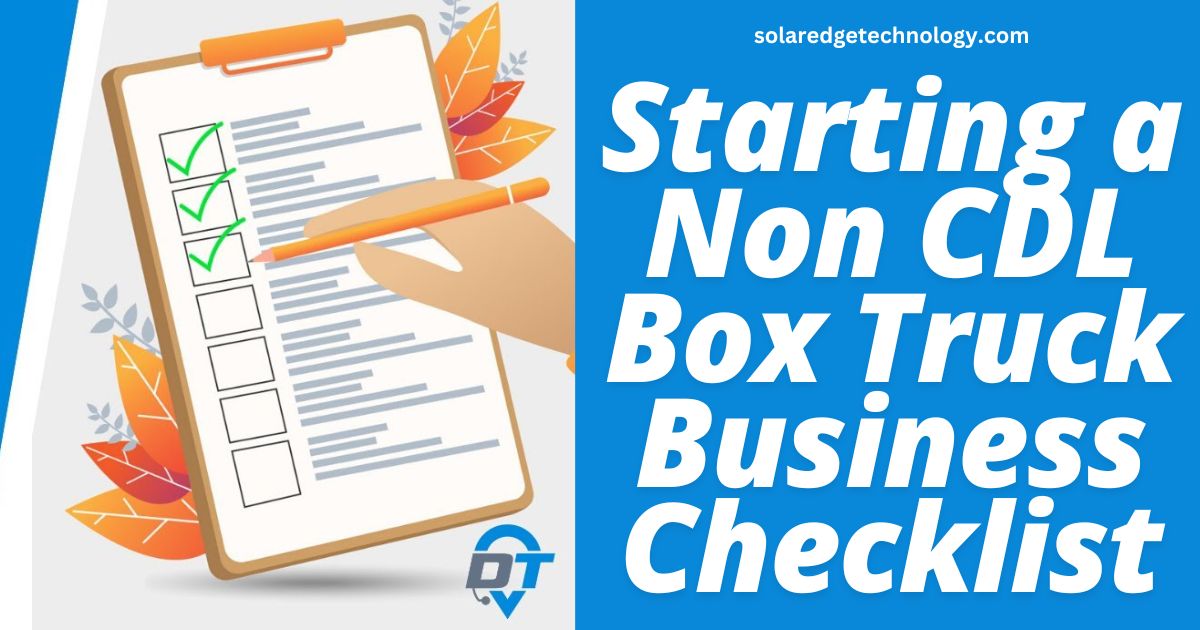The logistics and transportation industry is a booming sector with endless opportunities for entrepreneurs. If you’re considering entering the field without obtaining a Commercial Driver’s License (CDL), starting a non-CDL box truck business can be a great option. Non-CDL box truck businesses are ideal for small-scale operations and local deliveries, providing a flexible and profitable venture for aspiring business owners.
This article provides a comprehensive guide to starting a non-CDL box truck business checklist, covering everything from initial planning to scaling your operations. Whether you’re new to the industry or looking to refine your strategies, this checklist will ensure you’re well-prepared.
Key Takeaways
- Understanding Non-CDL Requirements: Learn the vehicle size and weight restrictions for non-CDL operations.
- Business Planning: Develop a solid business plan that outlines goals, services, and target markets.
- Legal and Licensing Essentials: Register your business and acquire the necessary permits.
- Vehicle Selection: Choose the right box truck that fits non-CDL criteria.
- Marketing Strategies: Create a brand presence to attract clients.
- Safety and Compliance: Prioritize vehicle maintenance and adhere to safety regulations.
What is a Non-CDL Box Truck?
A non-CDL box truck is a vehicle that does not require the operator to have a Commercial Driver’s License. These trucks typically:
- Have a Gross Vehicle Weight Rating (GVWR) of under 26,000 pounds.
- Are used for local deliveries, small-scale freight, and moving services.
Advantages of Starting a Non-CDL Box Truck Business
1. Lower Entry Barrier
Since a CDL isn’t required, the startup process is faster and less expensive.
2. Flexibility
Non-CDL box trucks are suitable for various operations, including furniture delivery, courier services, and e-commerce logistics.
3. Cost-Effective Operations
Fuel efficiency and lower maintenance costs make these trucks an affordable option.
4. High Demand
The growth of e-commerce and local businesses has increased the need for reliable delivery services.
5. Scalability
Start small and expand your fleet as your business grows.
Starting a Non-CDL Box Truck Business Checklist
1. Business Planning
Define Your Niche
Identify your target market and services. Common niches include:
- Local furniture delivery
- Small-scale freight
- E-commerce logistics
Conduct Market Research
Understand the competition, pricing, and demand in your area.
Create a Business Plan
Outline your goals, target audience, pricing, and operational strategies.
2. Legal and Licensing Essentials
Register Your Business
Choose a business structure (LLC, sole proprietorship, etc.) and register it with your state.
Obtain Necessary Permits
Research and acquire:
- DOT Number (if required)
- General liability insurance
- Local permits and licenses
Understand Tax Obligations
Register for an Employer Identification Number (EIN) and comply with tax regulations.
3. Choosing the Right Vehicle
Understand Non-CDL Requirements
Ensure the box truck meets the following:
- GVWR below 26,000 pounds
- Length and height appropriate for your business needs
Inspect Before Purchase
Examine:
- Engine condition
- Tires and brakes
- Mileage and maintenance records
Leasing vs. Buying
Decide whether to lease or buy based on your budget and operational needs.
4. Marketing Your Business
Create a Brand Identity
Design a logo, business cards, and a professional website.
Leverage Digital Marketing
Utilize social media, Google Ads, and SEO to reach potential customers.
Network Locally
Collaborate with small businesses and attend community events.
5. Operations and Maintenance
Prioritize Vehicle Maintenance
Regular inspections and timely repairs ensure safety and reliability.
Hire Reliable Drivers
If you expand your fleet, hire skilled drivers who meet non-CDL requirements.
Use Route Optimization Software
Minimize fuel costs and delivery times with efficient route planning.
Comparison Table: Non-CDL Box Truck vs. CDL Box Truck
| Feature | Non-CDL Box Truck | CDL Box Truck |
|---|---|---|
| License Requirement | No CDL required | CDL mandatory |
| Vehicle Weight | Under 26,000 pounds | Over 26,000 pounds |
| Operational Costs | Lower | Higher |
| Flexibility | Suitable for small businesses | Ideal for large-scale operations |
| Market Reach | Local deliveries | Long-distance and large cargo |
Keyword Cluster for Starting a Non CDL Box Truck Business Checklist
- Starting a non-CDL box truck business checklist
- Non-CDL box truck business startup
- Box truck business plan for non-CDL
- Non-CDL delivery business tips
- Small box truck business ideas
- Checklist for non-CDL box truck operations
- Best practices for non-CDL box truck businesses
FAQs
1. What is the difference between CDL and non-CDL box trucks?
CDL box trucks have a GVWR above 26,000 pounds and require a Commercial Driver’s License, while non-CDL trucks are under this limit and do not require a CDL.
2. What services can I offer with a non-CDL box truck?
You can offer local deliveries, furniture moving, courier services, and e-commerce logistics.
3. How much does it cost to start a non-CDL box truck business?
Startup costs vary but typically range from $10,000 to $50,000, depending on vehicle costs, permits, and marketing.
4. Do I need insurance for a non-CDL box truck business?
Yes, general liability insurance and vehicle insurance are essential for legal compliance and financial protection.
5. Can I scale my non-CDL box truck business?
Yes, you can expand by adding more trucks and services as your customer base grows.
Conclusion
Starting a non-CDL box truck business is an accessible and lucrative opportunity for entrepreneurs seeking entry into the logistics sector. By following this comprehensive checklist, you can establish a solid foundation for success. Focus on understanding legal requirements, selecting the right vehicle, and creating a robust marketing strategy. With dedication and smart planning, your non-CDL box truck business can thrive in today’s competitive market.
